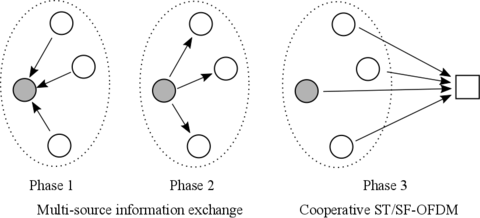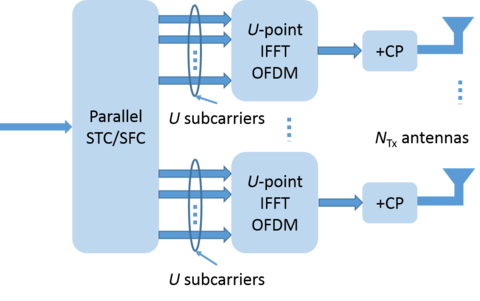Summary
Linear dispersion codes (LDC) can support arbitrary configurations of transmit and receive antennas in multi-input multi-output (MIMO) systems. In this work, we investigate two transmit diversity aided non-cooperative applications of LDC for orthogonal frequency division multiplexing (OFDM) systems in order to achieve space-time/frequency (ST/SF) diversity gains when transmitting over time-/frequency-selective fading channels. LDC-aided ST/SF-OFDM is flexible in configuring various numbers of transmit antennas and time-slots or frequency-tones. Therefore, we also apply the proposed scheme into cooperative wireless sensor networks, in which each sensor node employs single antenna. The cluster of sensor nodes carries out the so-called Multi-Source Information Exchange at Phase 1 and Phase 2, then all the node play as relays to form the cooperative transmissions during Phase 3.
Description
Broadband communication plays an increasingly important role in meeting the growing demand for high-speed multimedia transmissions in our daily lives. However, when the bandwidth of a signal exceeds the coherent bandwidth of the wireless channel, the small-scale fading imposed on the signal becomes frequency-selective rather than frequency-flat. Such a fading time-dispersion incurs inter-symbol interference (ISI) to the air-interface and degrades the link performance. Orthogonal frequency division multiplexing (OFDM) is one of the transceiver techniques designed to combat ISI.
In the context of wireless sensor networks, space-time codes and space-frequency codes have been well investigated, while only space-frequency codes are studied with OFDM systems. A further combined version of the above two schemes is known as space-time-frequency block coding, which can exploit diversity in all three domains. Furthermore, the various LDC-aided OFDMs has been proposed to achieve space-frequency diversity for the constant fading channel within a single OFDM block; while the LDC is designed to obtain diversity from the time and frequency domain rather than the spatial domain. Cooperative/distributed space-time, space-frequency, and space-time-frequency coded OFDM systems were proposed, respectively. However, to the best of our knowledge, there has not been a comprehensive investigation assessing distributed or cooperative LDC for an OFDM system for wireless sensor networks in terms of space-time (ST) and space-frequency (SF) diversity gain impacts with varying channel coherent times and bandwidths when communicating over mobile multipath channels.
In this work, we investigate transmit diversity for OFDM system that invokes cooperative LDC to take into account the trade-off between ST and SF diversities in the presence of Doppler and delay spreads, respectively. For the sake of simplicity, we assume the channels among cooperative nodes are perfect, hence the distributed MIMO are considered as the equivalent model of co-located ones. Our contributions are highlighted as follows:
- We unify the analyzing structure of cooperative diversity aided block codes in order to compare cooperative LDC with the corresponding Alamouti’s code and Tarokh’s code [7], [8] in diverse MIMO configurations.
- The cooperative LDC, Alamouti’s and Tarokh’s codes are applied to OFDM in both the ST and SF approaches.
- An LDC-aided ST-/SF OFDM system is capable of supporting arbitrary configurations of transmit nodes and receive antenna for cooperative wireless sensor networks, when combined with arbitrary modulation schemes.


Major Accomplishments
Our results show that when the channel is constant within the coherent time/bandwidth, the cooperative ST-OFDM or SF-OFDM is capable of achieving full diversity gain in space-time or space-frequency domains, respectively.
- We quantify the performance impact with varying Doppler spreads. Results show that the ST-OFDM scheme is sensitive to exploit diversity gains subject to the effect upon varying channel Doppler spreads.
- In parallel, we examine the performance impacts owing to varying numbers of paths in terms of delay spread.
- As a result, the performance of cooperative SF-OFDM is mainly subject to delay spreads.
- Compared to fixed orthogonal block codes, the cooperative LDC-aided ST/SF-OFDM is flexible to configure various numbers of transmit antennas and time-slots or frequency-tones.
- When the cooperative cluster employs more than two nodes, the performance of cooperative LDC-aided OFDM schemes is less impacted by channel Doppler/delay spreads, as compared with orthogonal block codes.

